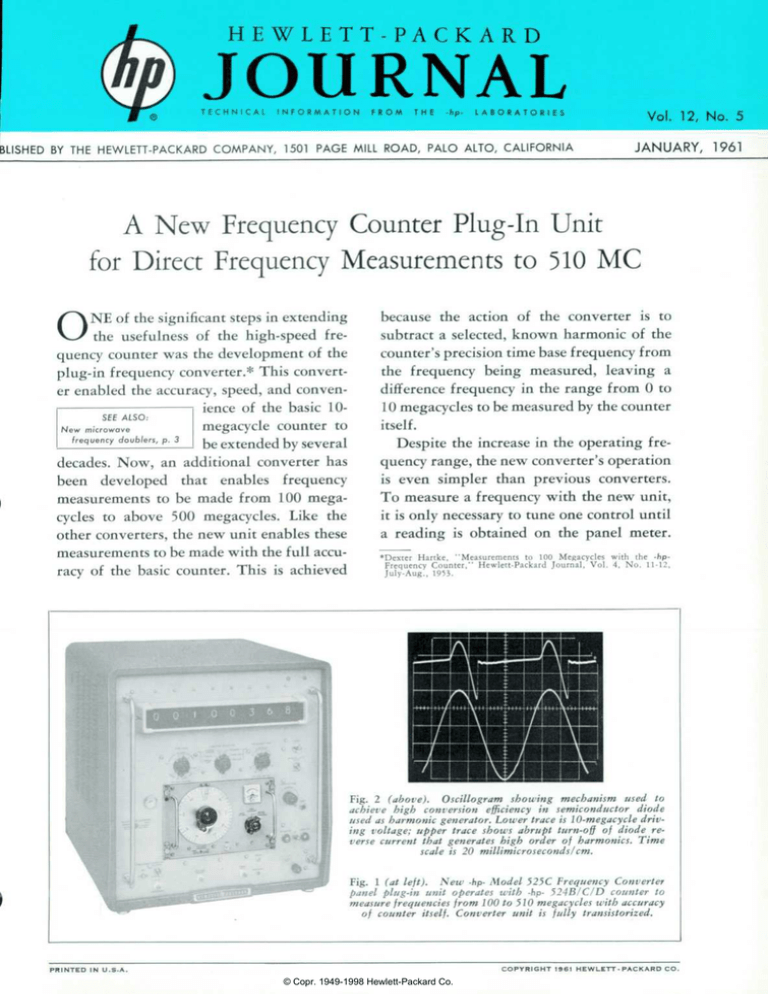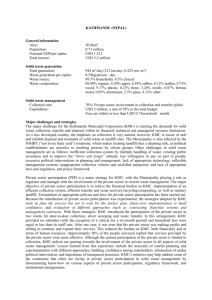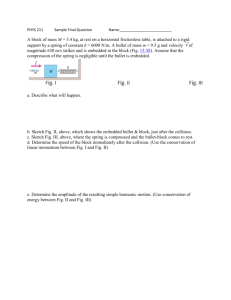JOURNAL H E W L E T T - P A...
advertisement

HEWLETT-PACKARD
JOURNAL
T E C H N I C A L
I N F O R M A T I O N
F R O M
T l
(ORATORIES
Vol. 12, No. 5
BUSHED CALIFORNIA THE HEWLETT-PACKARD COMPANY, 1501 PAGE MILL ROAD, PALO ALTO, CALIFORNIA
JANUARY, 1961
A New Frequency Counter Plug-In Unit
for Direct Frequency Measurements to 510 MC
ONE of the significant steps in extending
the usefulness of the high-speed fre
quency counter was the development of the
plug-in frequency converter. This convert
er enabled the accuracy, speed, and conven
ience of the basic 10SEE AtSO:
megacycle counter to
New microwave
frequency doubters, p. 3
be extended by several
decades. Now, an additional converter has
been developed that enables frequency
measurements to be made from 100 mega
cycles to above 500 megacycles. Like the
other converters, the new unit enables these
measurements to be made with the full accu
racy of the basic counter. This is achieved
because the action of the converter is to
subtract a selected, known harmonic of the
counter's precision time base frequency from
the frequency being measured, leaving a
difference frequency in the range from 0 to
10 megacycles to be measured by the counter
itself.
Despite the increase in the operating fre
quency range, the new converter's operation
is even simpler than previous converters.
To measure a frequency with the new unit,
it is only necessary to tune one control until
a reading is obtained on the panel meter.
•Dexter Hartke, "Measurements to 100 Megacycles with the -dpFrequency Counter," Hewlett-Packard Journal, Vol. 4, No. 11-12,
July-Aug., 1953.
Fig. 2 (above). Oscillogram showing mechanism used to
achieve high conversion efficiency in semiconductor diode
used as harmonic generator. Lower trace is 10-megacycle driv
ing voltage; upper trace shows abrupt turn-off of diode re
verse current that generates high order of harmonics. Time
scale is 20 millimicroseconds/ cm.
Fig. 1 (at left). New -hp- Model 525C Frequency Converter
panel plug-in unit operates with -hp- 524B/C/D counter to
measure frequencies from 100 to 510 megacycles with accuracy
of counter itself. Converter unit is fully transistorized.
P R I N T E D
I N
C O P Y R I G H T
U . S . A .
© Copr. 1949-1998 Hewlett-Packard Co.
I S 6 1
H E W L E T T - P A C K A R D
C O .
Direct Mode 10 ^ -10.1 me
-hp- 524B/C/D
COUNTER
Amplifier Mode SOkc^lO.lmc
~i
INPUT
O — X)
To 0-10mc
Counting
Circuits
J
TUNING
Fig. 3. Circuit arrangement of new converter unit. Besides
operating as frequency converter, unit can be used as amplifier
for measurements from 50 kc to 10.1 megacycles.
•
I
O
Fig. 4. Panel view of -hp- Model 525C Frequency Converter
Unit. Panel control tunes internal resonator to integral multiple
of 10-megacycle precision frequency from counter time base.
The frequency being measured is
then merely the sum of the reading
of the tuning control (which is al
ways a simple multiple of 10 mega
cycles) added to the reading of the
counter itself.
In addition to acting as a con
verter, the new plug-in also operates
as an amplifier for measurements in
the 50 kc— 10.1 megacycle range, in
creasing the sensitivity of the count
er to 20 millivolts for these frequen
cies. As a further convenience, the
plug-in will act as a direct feedthrough unit so that all basic counter
measurements in the 0—10 mega
cycle range can be made with the
unit in place.
conversion efficiency in semicon
ductor diodes used as harmonic
generators.
In the new converter a 10-mega
cycle precision frequency from the
counter's time base is applied to a
harmonic generator in the form of
a semiconductor diode. This diode
is specially designed to have a fast
rise time in its reverse current turnoff, thereby providing a mechanism
for increased efficiency of harmonic
generation. In operation the diode
is biased so that forward current will
flow for somewhat less than half of
a cycle of the applied 10-megacycle
voltage. This forward current builds
«A. F. Boff, J. Moll, and R. Shen, "A New HighSpeed Effect in Solid-State Diodes," 1960 Inter
national Solid-State Circuits Conference."
(concltided on p. 6)
CIRCUIT APPROACH
Circuitwise, the new converter has
the form indicated in Fig. 3. While
the circuit approach is substantially
that of the previous converters, the
development of this unit was made
possible by the discovery of a new
mechanism for obtaining higher
© Copr. 1949-1998 Hewlett-Packard Co.
Fig. 5. Typical conversion efficiency oj
harmonic generator used in new con
verter unit.
TWO NEW MICROWAVE FREQUENCY DOUBLERS
FOR EXTENDING SIGNAL SOURCES TO THE 18-40 KMC RANGE
«-FREOUEICr (INC)
Fig. 1. New Microwave Frequency Doubter enables existing
lower-frequency signal sources to provide signals in the 1826.5 kmc or 26.5 - 40 kmc ranges.
IN the range above about 20 kilomegacycles there has been a lack
of convenient and economical signal
sources, especially for broadband
work. To meet this situation, two
new frequency doubler sets have
been developed. These sets double
the output frequency of existing
lower-frequency signal sources and
thus make them usable for higher
frequency work. The two doubler
sets jointly extend the frequency of
generators in the 9 to 20 kmc range
to frequencies of 18 to 40 kmc. In
this range they will produce a
maximum of about 2 milliwatts.
Since the new sets double the out
put frequency of existing sources,
they can be used with several -hpsignal generators (Table I) to obtain
an 18-40 kmc signal that has all the
flexibility of the basic generator. If
the basic generator is a swept oscilla
tor, such as the -hp- 686A or 687A,
then a swept signal will be produced
at the doubled frequency. Similarly,
pulsed, f-m or c-w sources can be
used just as readily. Measurements
at the higher frequency are thus
often considerably simplified. When
used with either the -fip- 686A or
687A swept oscillators, the doublers
will typically provide one-half to
one milliwatt, which will meet most
applications.
Each doubler is further provided
with its own metering circuit and
attenuator so that the output level
at the doubled frequency can be
measured and adjusted. The output
attenuator is calibrated and has a
range from 0 to 100 db so that, with
the -hp- 686A or 687A sweep oscilla
tors, the sets will typically produce
an output from about 0 to -100 dbm.
Aside from the output attenuator
control, there are no tuning controls
or adjustments and the sets are
wholly passive in character.
INPUT
Fig. 2. Typical power output character
istic of new -hp- Model 938A Frequency
Doubler when driven with 10 milliwatts
from -hp- Model 686A voltage-tuned
sueep oscillator.
«-FBEOUEIICà {KC]
Fig. 3. Typical power output character
istic of new -hp- Model 940A Frequency
Doubler when driven with 10 milliwatts
from -hp- Model 687A voltage-tuned
sweep oscillator.
HARMONIC GENERATOR
The heart of the new doubler sets
is a crystal diode harmonic genera
tor (Fig. 4). Broadband performance
for this generator has been achieved
OUTPUT
9-13. 25 kmc
or
13.25 -20 kmc
POWER
LEVEL
Fig. 4. Circuit arrangement of Models 93 8 A and 940 A Fre
quency Doublers.
© Copr. 1949-1998 Hewlett-Packard Co.
rect-reading, being calibrated over
the full 100 db range.
SWEPT REFLECTOMETER
Fig. 5. New Frequency Doubler can be used with several -hpsignal sources, is shown with -hp- Model 626 A 10-15.5 kmc
signal generator.
by locating the diode directly in the
waveguide in a special wafer and by
matching inpedances through the
use of ridged guide. A lead is
brought from one terminal of the
crystal through the guide to a dc
meter on the panel of the set. The
meter reading that occurs is a valid
indication of the second harmonic
power being generated, since the
same non-linearities that produce a
second harmonic also produce the
dc component.
Since the harmonic generator pro
duces higher harmonics in addition
to the second, a suitable low-pass
filter has been incorporated. The
filter keeps higher harmonics gen
erally about 40 db below the main
output, except for the case of the
third harmonic of the lowest input
frequency. These harmonics lie
quite close to the top of the main
output range, i.e., to the top of the
filter pass band. This factor reduces
the degree of suppression of third
harmonics in this narrow area, but
they are still at least 8 db below the
main output. This amount of sup
pression in combination with the
wide frequency separation is ade
quate for most situations.
The low-pass filter is then fol
lowed by the precision 0-100 db
rotary attenuator. This unit is di
The new Frequency Doublers can
be used with the -hp- Models K422A
and R422A Broadband Crystal De
tectors (see inset) to form a practical
swept reflectometer set-up, as shown
in Fig. 6. A typical measurement
made with this set-up on a broad
band device is shown in Fig. 7.
A reflectometer using this new
equipment will differ slightly from
a set-up at lower frequencies because
of the smaller power available. The
main difference is that a 10-db rather
than a 20 db directional coupler
must usually be used to sample the
incident power. In addition, the
"Excess Coupler Loss" switch asso
ciated with the incident channel on
the -hp- Model 416A Ratio Meter
should be set as if a 20 db coupler
were being used (i.e., set the switch
to "10 db" excess loss). This pro
cedure is necessary to provide
enough signal amplitude in the in
cident channel to operate the inter
nal circuitry of the Ratio Meter. The
Ratio Meter can then be used nor
mally if the range switch is treated
as if the 30% range were 100%, the
10% range 30%, etc. It can be seen
that these procedures provide more
gain in both the incident and re
flected channels than is achieved by
TABLE
© Copr. 1949-1998 Hewlett-Packard Co.
•*-FIEOüE»Cà UNO
Fig. 7. Typical swept measurement
made using reftectometer set-up shown in
fig. 6.
Fig. 6. 5et-t//> /or forming swept reftectometer using new
frequency doubters.
the normal procedures used at lower
frequencies. Using this procedure,
reflection coefficients down to 3%
have been measured in the 26.5-40
kmc range on a swept basis at -hp-.
—Russell B. Riley
SPECIFICATIONS
-hp- MODEL 938A
FREQUENCY DOUBLER SET
-hp- MODEL 940A
FREQUENCY DOUBLER SET
Frequency Ronge: 18-26.5 kmc.
Conversion Efficiency: Approximately 18 db
at 10 mw input.
Output Power: Depends on input power sup
plied. Approximately .5 to 1.0 mw when
used with typical -hp- Model 626 Signal
Generator.
Input Power Required: 10 mw design center.
Maximum Input Power: 100 mw.
Frequency Range: 26.5 - 40 kmc.
Conversion Efficiency: Approximately 18 db
at 10 mw input.
Output Power: Depends on input power sup
plied. Approximately .5 mw when used
with typical -hp- Model 626A and 628A
Signal Generators.
Input Power Required: 10 mw design center.
Maximum Input Power: 100 mw.
Output Monitor Accuracy: ± 2 db.
Output Attenuator Accuracy: ± 2% of read
ing or ± .2 db whichever is greater.
Output Monitor Accuracy: ±1.5 db.
Output Attenuator Accuracy: ± 2% of read
ing or ± 0.2 db whichever is greater.
Attenuator Range: 100 db.
Output VSWR: Approximately 2 at full out
put. Less than 1.5 with attenuator set to
10 db or more attenuation.
Input Flange: M-Band flat cover flange for
WR-75 waveguide.
Output Flange: UG-595/U flat cover flange
for WR-42 waveguide.
Dimensions: 5 in. high, 19 in. wide, 18 in.
deep.
Weight: 20 Ibs.
Accessories Available: Waveguide Adaptors
MP292A, MX292A.
Price: $1500.00.
Attenuator Range: 100 db.
Output VSWR: Approximately 2 at full out
put. Less than 1.5 with attenuator set to
10 db or more attenuation.
Input Flange: N-Band flat cover flange for
WR-51 waveguide.
Output Flange: UG-599/U flat cover flange
for WR-28 waveguide.
Dimensions: 5 in. high, 19 in. wide, 18 in.
deep.
Weight: 20 Ibs.
Accessories Available: Waveguide Adaptor
NP292A, MP292A, NK292A.
Price: $1500.00.
Price f.o.b. factory
Data subject to change without notice
© Copr. 1949-1998 Hewlett-Packard Co.
BROADBAND CRYSTAL DETECTORS
FOR THE 18-40 KMC RANGE
The Models K422A and R422A De
tector Mounts specified in the reflectometer set-up (Fig. 6) of the accompany
ing article are newly-developed crystal
mounts which can be used for sweptfrequency reflectometer measurements
or for other applications where broad
band detectors are useful. In these de
tectors sensitivity is a remarkably smooth
function of frequency, the maximum de
viation over their 1.5:1 bands being ±2
db. This constant sensitivity is attained
by integrally locating the crystal in a
short section of waveguide. The optimum
load resistance for best square-law re
sponse is determined during manufac
ture, and the detector can be used with
this load resistance as a square-law de
tector or without it for maximum sensi
tivity.
The K422A Mount operates from 18
to 26.5 kmc, and the R422A Mount from
26.5 to 40 kmc. Specifications are given
in the table below.
SPECIFICATIONS
-hpMODELS K/R422A
WAVEGUIDE CRYSTAL DETECTORS
Frequency Range:
Model K422A: 18 to 26.5 kmc.
Model R422A: 26.5 to 40 kmc.
VSWR: 2.5:1.
Sensitivity: Better than 0.05 volt per milli
watt.
Frequency Response: ± 2 db.
Square Law Response: ± 1 db (-3 to -40
dbm).
Matched Pair: ± 2 db. Includes frequency
response and square law characteristics
combined but excludes basic crystal sen
sitivity.
Price: $200 each. Matched pair $420.
Price f.o.b. factory
Data subject to change without notice
-hp- Model 524B
-/IP- Model 524C
-hp- Model 524D
Fig. 6. New Converter can be used with above -hp- 10-tnegacycle frequency counters.
(Continued from p. 2)
up stored minority carriers at the
diode junction. When the diode
then becomes reverse-biased during
the later part of the cycle, these
carriers provide a reverse current
for a time. When the stored carriers
are depleted, however, the current
falls rapidly to zero with a rise time
that is typically less than a millimi
crosecond. This abrupt change in
the reverse current is responsible for
the high order of harmonic genera
tion that occurs.
Since the harmonics generated by
the diode occur only at discrete 10megacycle intervals, a desired indi
vidual harmonic can be selected by
a suitable tuned circuit. Such a
circuit is provided in the form of
a high-Q coaxial cavity resonator
which is tuned by the calibrated dial
at the converter panel. The cavity
drive system consists of a springloaded lead-screw and gear-reduc
tion drive that provide a high order
of tuning precision and stability.
Resonator dimensions are mini
mized by capacitively-loading an
otherwise higher-frequency resona
tor to bring its frequency to the
desired 100-500 me range. The
resonator drive system is also ar
ranged to provide a linear tuning
calibration.
The output of the resonator is
mixed with the frequency to be
measured (100-510 me) in a balanced
mixer and the resulting 0-10 me
difference frequency is amplified
and applied to the counter proper.
A meter in the difference-frequency
amplifier indicates to the operator
when the resonator is tuned to pro
vide a difference frequency in the
0-10 me range of the amplifier.
In the other positions of the input
selector switch, the difference-fre
quency amplifier can be used to in
crease the sensitivity of the counter
in the 50 kc— 10.1 me range from 1
volt to 20 millivolts. The switching
arrangement also enables external
signals to be applied directly to the
counter.
of the constant sensitivity thus
achieved, the need for controls other
than the resonator tuning control
is eliminated.
COMPATABILITY
The new converter can be used
directly with any of the following
models of 10-megacycle counters
manufactured by -hp-:
524B, 524C, 524D or FR-38/USM-26.
ACKNOWLEDGMENT
The development and electrical
design of the new converter were
carried out by A. Frank Boff, while
the mechanical design is due to
Frank Berry.
SENSITIVITY
From a usage point of view the
new converter has the desirable
characteristic that its sensitivity is
essentially constant over the full
100-500 me range. Besides being
constant, the sensitivity is high
enough (100 millivolts) to meet
most laboratory and production fre
quency-measuring situations.
The constant sensitivity charac
teristic is achieved by tailoring the
tuning mechanism so that the orien
tation of the resonator input and
output loops is changed as the reson
ator tuning is changed. This com
pensates for the variation in reson
ant harmonic amplitude which
occurs in a predictable manner over
the resonator tuning range. Because
© Copr. 1949-1998 Hewlett-Packard Co.
SPECIFICATIONS
-hp-
MODEL 525C
FREQUENCY CONVERTER UNIT
Range: As converter for counter, 100 MC to
510 MC. As amplifier for counter, 50 KC
to 10.1 MC. Direct connection for 0 to
10.1 MC.
Accuracy.- Retains accuracy of 524 Counter.
Registration: 9 places; first two places indi
cated on converter dial, next 7 displayed
by counter.
Input Voltage: 20 mv rms minimum, 50 KC
to 10.1 MC; 100 mv rms minimum, 100
MC to 510 MC.
Input Impedance: Approximately 700 ohms,
50 KC to 10.1 MC; Approximately 50
ohms, 100 MC to 510 MC.
Level Indicator: Meter aids frequency selec
tion; indicates usable voltage level.
Weight: Net 6'/2 Ibs. Shipping 11 Ibs.
Price: $425.00.
Price f.o.b. factory
Data subject to change without notice



